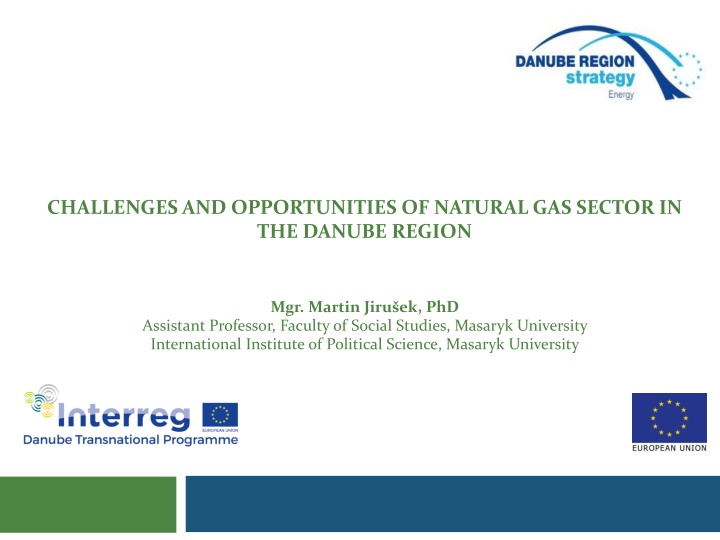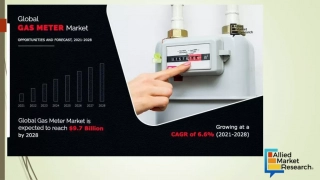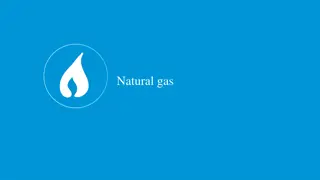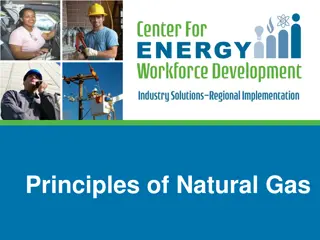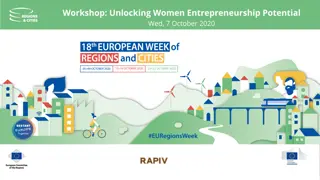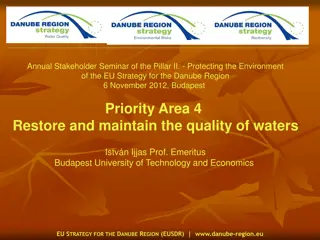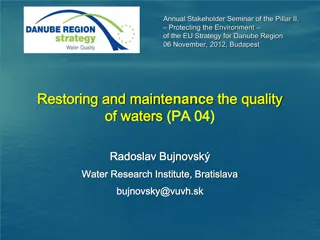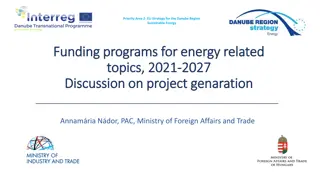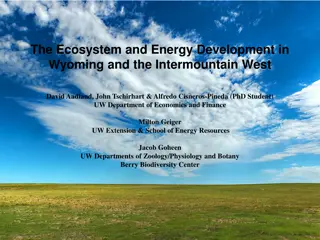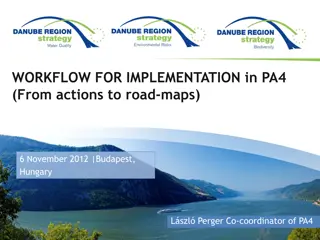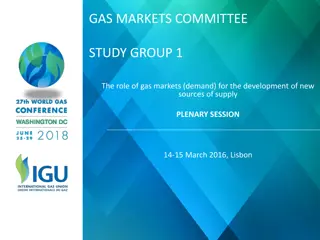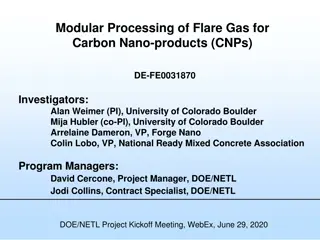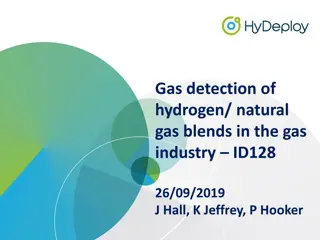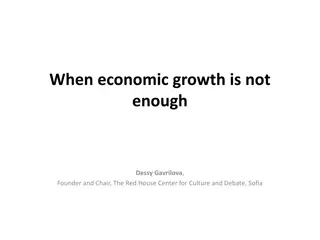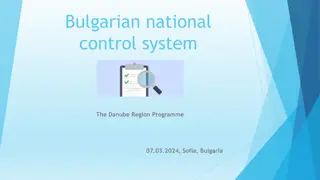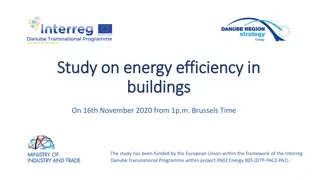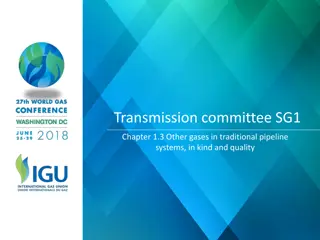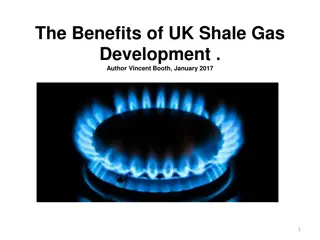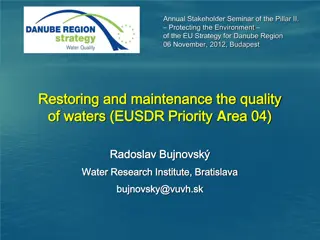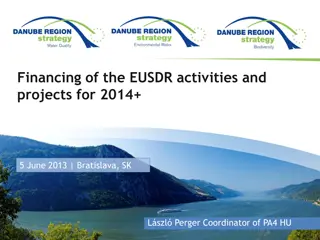CHALLENGES AND OPPORTUNITIES OF NATURAL GAS SECTOR IN THE DANUBE REGION
The natural gas sector in the Danube Region faces challenges like lack of cooperation, diverging interests, and country-specific hindrances, while also presenting opportunities for integration and development. The region's characteristics, including uneven development and varying energy policies among countries, impact the sector's growth potential and market integration.
Download Presentation

Please find below an Image/Link to download the presentation.
The content on the website is provided AS IS for your information and personal use only. It may not be sold, licensed, or shared on other websites without obtaining consent from the author.If you encounter any issues during the download, it is possible that the publisher has removed the file from their server.
You are allowed to download the files provided on this website for personal or commercial use, subject to the condition that they are used lawfully. All files are the property of their respective owners.
The content on the website is provided AS IS for your information and personal use only. It may not be sold, licensed, or shared on other websites without obtaining consent from the author.
E N D
Presentation Transcript
CHALLENGES AND OPPORTUNITIES OF NATURAL GAS SECTOR IN THE DANUBE REGION Mgr. Martin Jiru ek, PhD Assistant Professor, Faculty of Social Studies, Masaryk University International Institute of Political Science, Masaryk University
Challenges and opportunities of natural gas sector in the Danube Region 2
The Danube Region main characteristics The Danube Region is characterized by uneven development Western part of the region (GER, AUT) - established and interconnected gas markets - Central Europe (CE) relatively successful transformation, catching up with the West - South-eastern Europe (SEE) - serious obstacles to market development and integration - THEREFORE: The main issues hindering the development are related to the SE part of the region The SEE states are typical for higher share of the industrial sector in the economy and higherenergy intensity Natural gas is acrucial commodity for industrial sectorand households (heating) Supply curtailments may have severe impact despite relatively lower gas utilization - THEREFORE: Outages and supply cuts pose a serious threat due to their potential impact on industry and on sensitivesectors
Issue 1: Lack of will to cooperate, diverging interests and country-specific hindering issues Interestsof individual countries/market players as hindering factors for integration Diverging policies and discourses even within micro-regions of the Danube region CE countries differ in foreign policy discourses, which influences theirenergy policies CZ focuses on close cooperation with the western European markets (Gazelle) 1) Slovakia generally focuses on maintaining the country s transit role (Eastring) 2) Hungary focuses on securing its position; also takes a different foreign policy path in number of areas 3) SEE countries differ in terms of sectoral goals Romania - still an isolated island only slowly progressing in terms of interconnections for internal reasons, despite the potential for improving the situation in the region, 1) Slovenia a wholly different situation compared to the rest of former Yugoslavia; does not feel the urge to highlight the regional integration 2) Number of states struggle with the very basics (Moldova, BiH, Montenegro, ) 3) 4
Issue 1: Lack of will to cooperate, diverging interests and country-specific hindering issues Factors undermining market integration can be found alsoon the level of inner-state administration Deep ethnic cleavages - Bosnia & Herzegovina Ambiguity on the country's FP discourse and relations Serbia Territorial issues hindering reforms and investments Moldova Supply deals often influenced by corruption & non-transparency (non- transparent intermediaries - e.g. Serbia, Romania...) Politicization of infrastructural projects (Bulgaria South Stream)
Issue 2: Lack of strong, clearly formulated sectoral policies Lack of strong, clearly formulated sectoral policies is harmful especially for states whose natural gas sectors are underdeveloped Missing policies undermines development particularly in underdeveloped and dependent countries Sector development requires long-term policies for predictability and stability for investment decisions - No gudelines mean no goals and inability to procure reforms - Lack of focus causes failure in addressing one of the most imminent threats of the region - energy poverty
Issue 3: Lagging harmonization of pertinent legislation Majority of SEE states struggle with implementing the IEM rules ranging from minor issues within the current legislation and its enforcement to entire missing acts Most notable examples: BiH, Moldova, Serbia - IEM principles (as defined in the 3rd Energy Package) are levelling the playing field, effectively eliminating the advantage of outsize incumbents active on these markets (Gazprom and its subsidiaries) The EU s IEM rules are the crucial factor in pulling the laggard countries towards a functional energy market, partly substituting lacking visions and clear policies, providing the countries with a purpose for the development
Issue 4: Insufficient infrastructure East-West-oriented supply infrastructure with little flexibility In SEE the infrastructure is sparser compared to the CE (not mentioning WE) I. The infrastructure is East-West oriented, overly dependent on a single supplier (Russia) II. III. The situation ischanging only slowly IV. Inadequate intra-state infrastructure and mutual interconnectivity 1/3 of the post-communist countries in the Danube Region are 100% dependent on Russian supplies with no viable alternative: Bulgaria, Serbia, Bosnia and Herzegovina, and Moldova States in SEE are often dependent on a single supplier and often also on a single supply route (i.e. weakened supply security), e.g.: Bulgaria crisisof 2009 I. Moldova high politicization of supplies influencing both energy security and political stability II. III. Serbia & Bosnia and Herzegovina - threats of cutting off supplies due to the accumulated debt The network in SEE lacks interconnectivity, source & route diversification, and flexibility 8
Issue 4: Low natural gas utilization and sector development Anchor (IAP, EC Gas Ring) loads for large-scale projects are higher than current demand Lacking incentives for large-scale infrastructural as well as intra-state projects Lack of indigenous resources insufficient domestic resources a) unclear potential of reserves (Black Sea conventional/unconventional, Adriatic Sea) b) Bulgaria potentially large deposits (up to ca. 480 bcm) moratorium imposed after public protests in 2012, confirmed in 2015 - Romania prospective offshore fields in the Black Sea (related: Crimea annexation); - shale gas reserves up to 1,5 tcm questionable economic viability Croatia potential gas fields in the Adriatic Sea facing environmental concerns - Montenegro potential gas fields in the Adriatic Sea - 9
Issue 4: Low natural gas utilization and sector development Low natural gas utilization No investor is willing to make the decision due to missing incentives Large-scale projects need solid economic rationale The utilization will not increase without additional supply The rationale is missing due to low utilization
Issue 5: Lack of reliable information sources Lack of necessary information hinders cooperation and advising Poor information coverage of SEE countries Internal issues hinder information services Bosnia & Herzegovina, Moldova - Information may be kept secret as a result of the state s or main stakeholder s policy - Diverging policy goals may (again) be the obstacle - Cooperating on information exchange is crucial for developing the functioning marketand also supporting programs Energy Community does an important job in providing interconnecting EU and non-EU members
Conclusion & Recommendations for SEE countries The main obstacles to the development of the natural gas market in the Danube Region are related to the countries located in south-eastern part of the region Implement and enforce the IEM rules 1. - The IEM rules level the playfield and introduce market-based measures Increase transparency within the sector 2. Increase interconnectivity and work on source and route diversification 3. Implement and conduct clear and focused sectoral policies to enhance the stability and predictability of the sector 4. Improve information services and exchange of information and data 5.
Opportunities New sourcesof natural gas (conventional & unconventional) Black Sea, Adriatic Sea - Infrastructural projects with a region-wide impact Turkish Stream + Tesla Pipeline - Eastring - EC Gas Ring - IAP - Adria LNG + related infrastructure - SE part of the Danube Region may become an important crossroad of infrastructural projects, increasing its importance for natural gas supplies within and even beyond the Danube Region
Thank you for your attention! http://energy.fss.muni.cz/ jirusek.martin@mail.muni.cz
